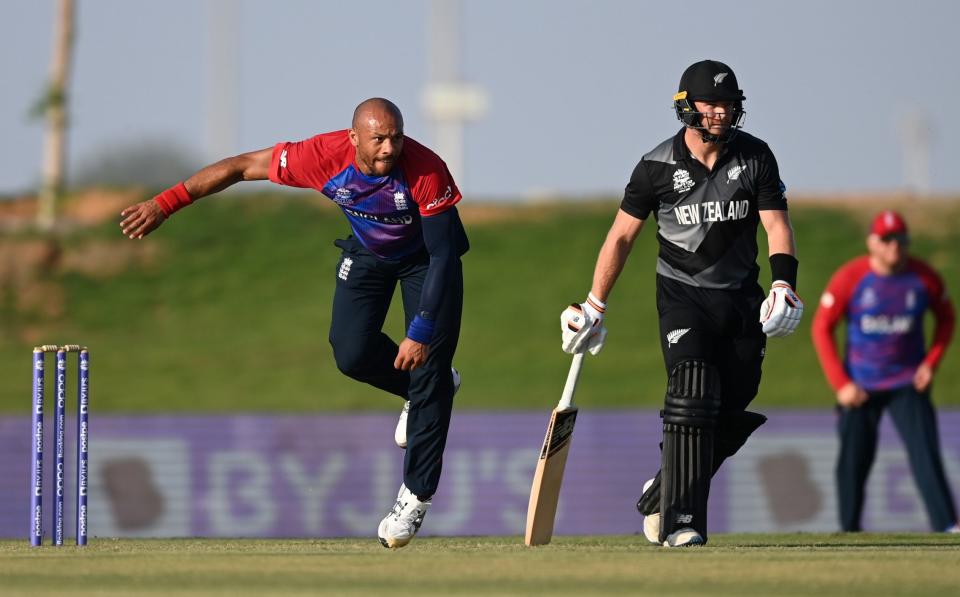The trends that will dominate this T20 World Cup - and how Moeen Ali and Tymal Mills can drive them

No format of cricket - perhaps not even any sport - is evolving as quickly as Twenty20. And yet, owing to scheduling and Covid-19, it has been 55 months since the last T20 World Cup finished with Carlos Brathwaite’s heist. These are the trends to watch out for in the main stage of this year’s World Cup, which begins on Saturday.
Hyper specific match-ups
In the last T20 World Cup final, England entrusted the second over to Joe Root’s off spin. Root duly dismissed Gayle.
The decision to bowl Root was based on the concept of match-ups: the idea that a team should use particular bowlers against opponents who struggle against their type of bowling. England knew Gayle had a weakness against off spin, leading them to bowl Root.
While originally used more by bowling sides, match-ups are also being embraced more eagerly by batting teams. In Test cricket, a batting order is almost a fixed concept; in T20, it is more like the basis for negotiation. Flexible batting orders to pair a left and right-hander at the crease are already becoming ever-more common. Teams will also tailor their batting orders to have complementary strengths - for instance, a pace hitter alongside a spin hitter - and promote a batsman to target a specific bowler.
Some batsmen even turn down singles to stay on strike against a bowler they are well-suited to taking down. In a Caribbean Premier League game last year, Kieron Pollard rejected a single, and then duly launched the last two balls of Hayden Walsh’s over for six.
Yet a match-up isn’t just tactical. “The psychological aspect of it sometimes plays on the opposition's mind if you know you're coming up against someone who you're not accustomed to, or you're not comfortable facing in a particular situation,” says Pollard, the West Indies captain. Match-ups “play a huge role and tactically it works more often than not”.
The best illustration of match-ups is the very first over of an innings. It could well be, for instance, that Moeen Ali doesn’t bowl at all in some England games - and then bowls the very first over against South Africa, aiming to exploit Quinton de Kock’s vulnerability to off spin.
Win the Powerplay, win the match?
During the second stage of the IPL, played on the same pitches in the UAE that will host the main stages of the World Cup, 74 per cent of matches were won by the team to score more runs in the Powerplay. Later in the innings, “it’s like the air goes out of the ball,” Australia’s captain Aaron Finch said.
The importance of the Powerplay explains why England are seriously considering dropping Dawid Malan for the first match. Malan’s style of beginning his innings slowly and making scant use of the fielding restrictions in the first six overs, is simply ill-suited to the need to exploit the Powerplay. The belligerence of Moeen Ali at three, repeating a role he performed at times for IPL champions Chennai Super Kings, would seem a better fit.

The anchors fight back?
Curiously, the heightened emphasis on the Powerplay this World Cup might go hand-in-hand with another, seemingly contradictory, development: the importance of anchor players to control the innings, largely in the middle overs after the Powerplay.
In T20, classical anchor players are most valuable in two situations - when matches are low-scoring, and when bowling is exceptional. The World Cup should see both these forces at work, with matches played on used wickets and, with no bowlers rested, the quality of bowling - especially rapid pace - elevated from the norm in bilateral T20 cricket.
Getting, say, 150, on a tough pitch against challenging bowling tends to demand classical skills - a robust defence against pace and spin alike, and the ability to locate gaps and accumulate at low-risk - that many power hitters lack. Kane Williamson led Sunrisers to the IPL final in 2018, averaging 52.5 on often treacherous pitches.
Captaining New Zealand in the World Cup, Williamson will be part of a group of anchors with high-class techniques who thrive in Test cricket, alongside Babar Azam, Steve Smith and Virat Kohli. One name, normally bracketed in this rarefied grouping, is a notable exception. Despite his lack of T20 match-time, there is a case to be made that, if the pitches do lend themselves to low-scoring games, Joe Root’s exemplary technique and aptitude against spin would have been an asset. In his absence, Jonny Bairstow's role controlling the innings against spin will be crucial.
Spin hitters in the middle overs…
Last year, after spending virtually his entire T20 career opening the batting, Chris Gayle shuffled down to number three - where, aged 42, he will bat for the West Indies in their World Cup defence. The shift reveals much about the development of T20 strategy.
Essentially, there were two reasons to adjust Gayle’s role. The first was negative - his propensity for starting slowly, meaning that he has sometimes failed to exploit the Powerplay. The second was positive - his penchant for hitting sixes in the middle overs, especially against spin. As a left-hander, Gayle is particularly well-suited to attacking leg spinners, who have thrived in T20; all of the eight teams to qualify automatically for the Super 12s have at least one. But leg spinners now face a new challenge, with left-handers now facing more balls in the middle order and teams attempting to have at least one left-hander at the crease throughout the middle overs, so they can hit orthodox leg spin with the turn.
… And enforcers to combat the spin hitters
Newton's Third Law states that, for every action there is an equal and opposite reaction. T20 is evolving so rapidly that the rise of spin hitters in the middle overs over the last two years has also beget a response: rapid pace bowlers - enforcers - being used in the middle overs to combat the spin hitters. Enforcers, like New Zealand’s Lockie Ferguson and South Africa’s Anrich Nortje - Mark Wood will play the role for England - pound the pitch with short-of-length deliveries exploiting any vulnerability to high pace and the short ball. Middle order batsmen already needed to be masters at dealing with wrist spin; now, they must be able to score rapidly against 90mph bowling, too.
The death of the yorker?
When the fielding side are struggling during the death overs, the most common refrain - from commentators and fans alike - is ‘bowl more yorkers’. But while a brilliant yorker is the consummate delivery at the death, yorkers are T20’s death or glory ball - err infinitesimally in either direction, and the batsman is presented with a half-volley or full-toss. Even when yorkers are delivered almost perfectly, batsmen are increasingly adept at scooping the ball over fine leg: the number of scoop and ramp shots played in each IPL season has almost doubled since 2017.
Tymal Mills has been the most economical death bowler since the last T20 World Cup. He has done so adopting a radically different approach to the norm: largely eschewing yorkers, Mills prefers back-of-a-length deliveries, which have a higher margin for error, benefiting from his pace and left-arm angle. While Mills is developing a fine yorker, too, he uses it sparingly, preventing batsmen from being able to premeditate scoops. And so if reports of the death of the yorker, like that of Mark Twain, have been exaggerated, the best yorker bowlers are now the ones who use the delivery smartest.

Managing the dew
While the tournament favourites India plumped for four specialist spinners, England’s selection of only one specialist spinner in their squad seems curious. As well as reflecting the dearth of England spin options, one explanation is the dew. As the temperature in the UAE cools, the dew is expected to exert a greater influence on night matches as the tournament progresses. Indeed, it has already become far more significant in recent weeks.
“With it cooling down a little now, it might become more of a factor,” observes Andy Flower, who was assistant coach for Kings XI Punjab and is now working as a consultant for Afghanistan. “I hope it doesn't have a huge effect on the tournament, because dew can sway the result.”
Dew essentially changes the dynamics in three ways. It makes winning the toss more important, which no team can control. It also tends to hinder spinners more than seamers, potentially endorsing England’s seam-dominant strategy. Among seamers, bowlers who pitch shorter tend to be less vulnerable to dew than those who strive for yorker lengths - potentially favouring Mills and Wood for England, but making Chris Jordan vulnerable, as conceding 20 off the 19th over in the warm-up defeat to India suggested.
How all teams grapple with the dew could be a defining feature of who thrives in the tournament. If England reach the final, six of their seven matches - all bar one group game with a qualifier from the first round - will be night games.
Dew playing a pivotal role might be bad for the tournament - but it could well be good for England. With their abundance of seamers, and several seamers who bowl shorter, England have the most dew-proof attack of any of the major contenders.

 Yahoo Sport
Yahoo Sport 





































